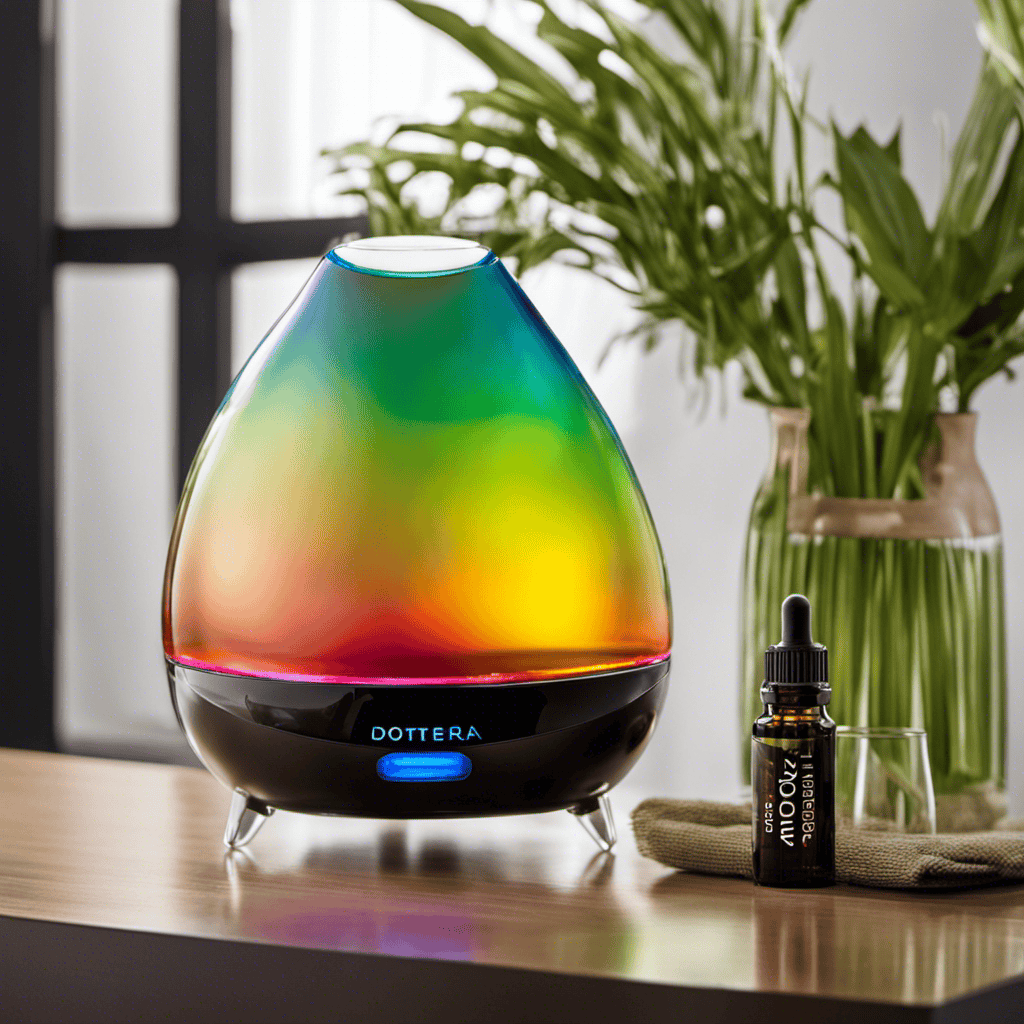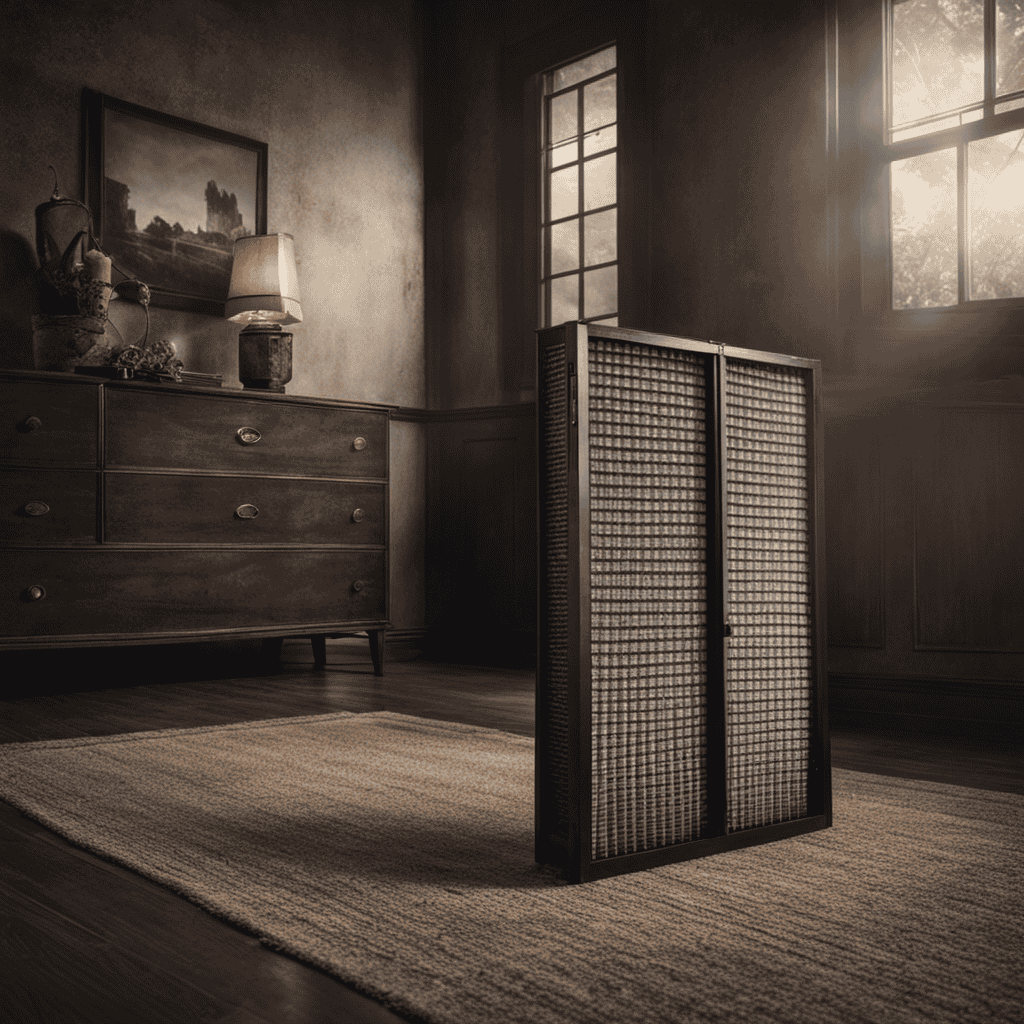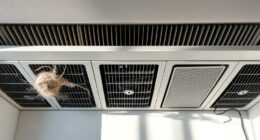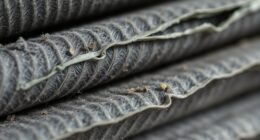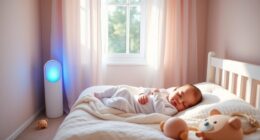I have some important news to share with you: did you know that regular filter changes are essential for ensuring the effectiveness of your Levoit air purifier?
In fact, failing to replace the filter regularly can lead to decreased performance and even potential health risks.
In this article, I’ll guide you through the factors that affect the filter lifespan, the recommended change frequency, and the signs that indicate it’s time for a replacement.
Let’s dive in and ensure your air purifier is working at its best!
Key Takeaways
- The recommended filter change frequency for Levoit Air Purifier is every six to eight months.
- Factors such as air quality, number of people in the household, presence of pets or smokers, high pollution levels, and large household can influence the replacement frequency.
- Signs indicating the need for filter replacement include reduced airflow, increased dust accumulation, and allergies or respiratory issues.
- Regular filter maintenance and cleaning, as well as following proper cleaning techniques and consulting the user manual, can help extend the filter’s lifespan and maintain efficiency.
Factors That Affect the Filter Lifespan
One of the factors that can affect the filter lifespan is the level of air pollution in your area. When the air is heavily polluted, the filter will have to work harder to trap and remove the contaminants, which can lead to a shorter lifespan.
Other factors that can impact filter longevity include the frequency of use, the size of the particles being filtered, and the overall maintenance of the air purifier.
To maximize the lifespan of your Levoit air purifier’s filter, it is important to follow some best practices for filter maintenance. Regularly cleaning the pre-filter and replacing it when necessary will prevent larger particles from clogging the main filter. Additionally, changing the main filter according to the manufacturer’s instructions will ensure optimal performance.
Taking these steps will help extend the lifespan of your filter and maintain the effectiveness of your air purifier.
Transitioning into the subsequent section about recommended filter change frequency, it is important to understand how often the filter should be changed to ensure clean and healthy air.
Recommended Filter Change Frequency
The recommended frequency for replacing the filter in the Levoit air purifier is every six to eight months. However, several factors can influence the replacement frequency of the filter. These factors include the air quality in your surroundings, the number of people in your household, and the presence of pets or smokers. If you live in an area with high pollution levels or have a large household, you may need to replace the filter more frequently. Timely filter changes offer numerous benefits, such as improved air quality, reduction of allergens and pollutants, and increased lifespan of the air purifier itself. By regularly replacing the filter, you ensure that the air purifier continues to effectively capture airborne particles and contaminants, providing you with clean and fresh air to breathe.
| Factors Influencing Replacement Frequency | Benefits of Timely Filter Changes |
|---|---|
| Air quality in surroundings | Improved air quality |
| Number of people in household | Reduction of allergens |
| Presence of pets or smokers | Decreased pollutants |
| High pollution levels | Increased lifespan of purifier |
| Large household | Clean and fresh air |
Signs That Indicate It’s Time to Change the Filter
If you notice decreased airflow or a musty smell, it may be time to replace your air purifier’s filter. Regularly changing the filter is crucial to maintain the effectiveness of your air purifier and ensure the quality of the air you breathe. Here are some signs that indicate it’s time for a filter change:
- Reduced airflow: If you notice that the air purifier is not circulating air as efficiently as before, it could be a sign of a clogged filter.
- Increased dust accumulation: A clogged filter will struggle to capture and trap dust particles, resulting in more dust settling in your home.
- Allergies or respiratory issues: If you or your family members experience increased allergy symptoms or respiratory problems, a dirty filter might be the culprit.
To prolong the lifespan of your filter, you can vacuum it regularly or use a brush attachment to remove larger particles. However, it’s important to replace the filter when necessary to maintain optimal performance. Understanding the different types of filters will further enhance your air purifier’s efficiency and effectiveness in purifying the air.
Understanding the Different Types of Filters
To enhance the efficiency and effectiveness of your air purifier, it’s important for you to understand the different types of filters available.
There are several different filter materials commonly used in air purifiers, each with their own unique benefits. The most common types include activated carbon filters, HEPA filters, and ionizers.
Activated carbon filters are effective at removing odors and gases from the air, while HEPA filters are highly efficient at capturing particles as small as 0.3 microns. Ionizers work by releasing negatively charged ions into the air, which attach to particles and make them easier to filter out.
When comparing filter effectiveness, HEPA filters are generally considered the gold standard, as they can remove up to 99.97% of airborne particles. However, it’s important to note that the effectiveness of a filter also depends on factors such as the size of the room and the air purifier’s airflow.
Understanding the different types of filters and their effectiveness can help you make an informed decision when choosing an air purifier for your home. Now, let’s move on to the next section and discuss how to properly maintain the filter.
How to Properly Maintain the Filter
When it comes to maintaining optimal air quality in your home, it’s important to understand the filter replacement frequency and the cleaning methods for the filter.
Regularly replacing the filter is essential to ensure that it continues to effectively remove pollutants from the air.
Additionally, knowing the proper cleaning methods for the filter can help extend its lifespan and maintain its efficiency.
Filter Replacement Frequency
Make sure you’re aware of how often you should change the filter in your Levoit air purifier. The filter replacement frequency depends on several factors that can affect its lifespan. Here are some important considerations:
- Air quality: If you live in an area with high pollution or have pets, the filter may need to be replaced more frequently.
- Usage: The more hours per day you run the air purifier, the more often the filter will need to be changed.
- Filter type: Different Levoit air purifiers use different types of filters, and each has a specific lifespan.
Regularly changing the filter in your Levoit air purifier has several benefits, including:
- Improved air quality: A clean filter can effectively remove pollutants, allergens, and odors from the air.
- Better performance: A clogged filter can decrease the air purifier’s efficiency, so changing it regularly ensures optimal performance.
- Longevity of the air purifier: Regular filter replacement helps extend the lifespan of your Levoit air purifier, ensuring it works effectively for years to come.
Remember to consult the user manual or contact Levoit for specific recommendations on when to change the filter in your air purifier model.
Cleaning Methods for Filter
Ensure that you regularly clean the filter in your air purifier to maintain its effectiveness and prolong its lifespan. Cleaning the filter is an essential part of filter maintenance, as it helps remove accumulated dust, allergens, and other particles that can clog the filter and reduce its efficiency.
There are different cleaning techniques you can use depending on the type of filter in your air purifier. For washable filters, gently remove the filter and rinse it with water. Allow it to dry completely before reinstalling it.
For non-washable filters, use a vacuum cleaner with a brush attachment to remove dust and debris. It is important to follow the manufacturer’s instructions for cleaning to ensure proper maintenance of your air purifier’s filter.
Regular cleaning will help your air purifier function optimally and provide you with clean and fresh air.
Ensuring Optimal Air Quality
To maintain optimal air quality, it’s important to regularly clean the filter in your air purifier. Clean air filters provide several benefits, including improved indoor air quality. A clean filter traps airborne particles such as dust, pollen, pet dander, and mold spores, preventing them from recirculating in your home. This helps reduce allergies and respiratory issues.
Another benefit of clean air filters is efficient air purification. When the filter is clean, the air purifier can effectively remove pollutants, odors, and harmful gases from your indoor environment. This ensures that you breathe in clean and fresh air.
Regular filter maintenance also extends the lifespan of the air purifier. It helps prevent clogging and strain on the purifier’s motor. By keeping the filter clean, you can prolong the life of your air purifier and save money on repairs or replacements.
Remember to follow the manufacturer’s instructions for filter maintenance to ensure maximum effectiveness and longevity of your air purifier.
The Importance of Regular Filter Replacement
As a proud owner of a Levoit air purifier, I’ve realized the importance of regular filter replacement. It’s crucial for maintaining the lifespan and efficiency of the device. The filter lifespan can vary depending on factors like air quality and usage. However, it’s generally recommended to replace the filter every 6 to 8 months.
Regular filter replacement ensures that the air purifier continues to effectively remove allergens, dust, and other pollutants from the air. This promotes better indoor air quality and provides health benefits for the whole family.
Filter Lifespan and Efficiency
You’ll want to check the filter lifespan and efficiency to ensure your Levoit air purifier is working effectively. Regular maintenance and proper filter management are essential for maintaining optimal performance.
Here are some tips to help improve filter efficiency and prolong its lifespan:
- Clean or replace the pre-filter regularly to prevent the build-up of large particles and extend the life of the main filter.
- Consider using a filter replacement indicator, which will notify you when it’s time to change the filter based on its usage and air quality conditions.
- Use the air purifier on the appropriate fan speed setting for the room size and air quality level, as higher speeds may reduce filter lifespan.
- Avoid placing the air purifier in areas with excessive dust, smoke, or pet dander, as these can clog the filter faster.
Health Benefits of Replacement
Regularly replacing the filters in your air purifier can help improve the air quality in your home and reduce the presence of allergens and pollutants. This not only has health benefits but also ensures the filter’s effectiveness in capturing and trapping airborne particles. When filters become clogged with contaminants, they can no longer effectively remove pollutants from the air, leading to decreased air quality and potential health issues. By replacing your air purifier filters on schedule, you can maintain optimal performance and enjoy cleaner, healthier air.
| Filter Type | Recommended Replacement Interval | Filter Effectiveness |
|---|---|---|
| Pre-filter | Every 3 months | Captures larger particles like dust and pet hair |
| True HEPA filter | Every 6-12 months | Removes 99.97% of particles as small as 0.3 microns |
| Activated Carbon filter | Every 6-12 months | Absorbs odors, gases, and chemicals |
Replacing your air purifier filters regularly not only promotes better air quality but also extends the lifespan of your air purifier itself. By ensuring that the filters are clean and functioning properly, you can prevent strain on the system and maintain its efficiency for longer periods of time.
Extending the Lifespan of Your Air Purifier Filter
To extend the lifespan of your air purifier filter, it’s important to regularly clean and maintain it. Here are some filter maintenance tips that can help you keep your air purifier running efficiently for longer:
-
Vacuum the pre-filter: Use a vacuum cleaner with a brush attachment to remove dust and debris from the pre-filter. This will prevent the build-up of dirt on the main filter, allowing it to function optimally.
-
Wash the filter: If your air purifier has a washable filter, follow the manufacturer’s instructions to clean it. This will remove trapped particles and improve the filter’s performance.
-
Replace the filter when necessary: Even with proper maintenance, filters eventually reach their maximum lifespan. Check the manufacturer’s guidelines to determine when it’s time to replace your filter.
Following these filter maintenance tips will not only extend the lifespan of your air purifier filter but also ensure that it continues to effectively remove pollutants from your indoor air.
Not All Filters Are Created Equal: Which One Is Right for You
When it comes to air purifiers, understanding the different types of filters is crucial in ensuring optimal air quality.
In this discussion, we will explore the various filter types available and their specific functions.
Additionally, we will delve into the importance of choosing the right filter based on your specific needs and the factors to consider in making this decision.
Lastly, we will discuss the longevity and maintenance of filters, providing valuable insights on how to extend their lifespan and ensure their effectiveness.
Filter Types Explained
You’ll want to understand the different filter types in order to make an informed decision about which one is best for your Levoit air purifier. The filter is a crucial component of the air purifier, responsible for trapping pollutants and improving indoor air quality.
Here are the different filter types you should know about:
- HEPA Filter: Highly efficient in removing airborne particles as small as 0.3 microns, capturing 99.97% of pollutants.
- Activated Carbon Filter: Effectively absorbs odors, gases, and chemicals, making it ideal for households with pets or smokers.
- Pre-Filter: Traps larger particles like dust and hair, extending the lifespan of the main filters.
To maintain filter efficiency and prolong its lifespan, follow these tips:
- Regularly clean or replace the pre-filter.
- Change the HEPA and activated carbon filters as recommended by the manufacturer.
- Keep an eye on the filter replacement indicator, if your air purifier has one.
Understanding filter efficiency and following proper maintenance tips will ensure your Levoit air purifier continues to provide clean and healthy indoor air.
Now, let’s move on to choosing the right filter for your specific needs.
Choosing the Right Filter
Now that we have explored the different types of filters available for the Levoit air purifier, let’s discuss how to choose the right filter for your needs.
Levoit offers a variety of filter options, each designed to target specific contaminants in the air. The main filter options include the True HEPA filter, activated carbon filter, and pre-filter.
The True HEPA filter is ideal for capturing small particles like dust, pollen, and pet dander. The activated carbon filter is effective at removing odors, smoke, and harmful gases. Lastly, the pre-filter helps to trap larger particles and prolong the lifespan of the other filters.
To maintain the effectiveness of your filters, it is important to follow proper maintenance techniques. This includes regularly cleaning or replacing the filters as recommended by the manufacturer. Additionally, it is important to clean or vacuum the pre-filter to remove any accumulated dust or debris.
In the next section, we will discuss the longevity and maintenance of Levoit air purifier filters, which will further help you understand how to care for your filters and ensure their optimal performance.
Longevity and Maintenance
Regular cleaning and following the manufacturer’s recommendations are important for maintaining the longevity and effectiveness of your air purifier filters. Here are some maintenance tips to ensure you get the most out of your filters:
-
Vacuuming: Regularly vacuum the surface of the filter to remove any dust or debris that has accumulated. This helps to maintain the filter’s efficiency and prolong its lifespan.
-
Washing: Some air purifier filters are washable. Follow the manufacturer’s instructions to properly clean the filter. This can help remove trapped particles and improve the filter’s performance.
-
Replacement schedule: Check the manufacturer’s recommendations for how often the filter should be replaced. Following this schedule ensures that your air purifier continues to work effectively.
By following these maintenance tips, you can enjoy the longevity benefits of your air purifier filters and ensure that your air remains clean and fresh.
Now, let’s move on to how you can check if your filter needs to be replaced.
How to Check if Your Filter Needs to Be Replaced
To determine if your filter needs to be replaced, simply check the filter indicator light on your Levoit air purifier. This indicator light is a convenient feature that lets you know when it’s time to change the filter.
However, there are also other signs you can look out for to prolong the lifespan of your filter and ensure optimal performance.
One of the main signs of a clogged filter is a noticeable decrease in air flow. If you feel like the air purifier is not circulating air as efficiently as before, it may be time to clean or replace the filter.
Another sign is an increase in dust and allergens in your environment. If you notice more particles floating in the air or settling on surfaces, it’s a good indication that your filter is no longer effectively capturing contaminants.
By regularly checking the filter indicator light and being mindful of these signs, you can ensure the longevity of your filter and maintain the air quality in your space.
Now let’s move on to the next section and discuss some common mistakes to avoid when changing the filter.
Common Mistakes to Avoid When Changing the Filter
When it comes to proper filter installation, there are a few key points to keep in mind.
First, make sure to carefully follow the manufacturer’s instructions to ensure the filter is installed correctly.
Second, double-check that the filter is securely in place to prevent any air leaks or gaps.
Lastly, it’s important to regularly maintain your filter to ensure optimal performance. This includes cleaning or replacing the filter according to the manufacturer’s recommendations and regularly checking for any damage or clogs.
Proper Filter Installation
Make sure you’re following the proper filter installation instructions for your Levoit air purifier. Improper filter installation can lead to reduced performance and potential damage to your purifier.
Here are some filter installation tips to ensure you do it correctly:
-
Before installing a new filter, make sure the purifier is turned off and unplugged.
-
Carefully remove the old filter, disposing of it properly.
-
Take the new filter out of its packaging and remove any protective coverings.
-
Align the new filter with the filter slot in the purifier, making sure it fits securely.
-
Gently push the filter into place until it clicks or locks into position.
-
Double-check that the filter is installed correctly and securely.
-
Plug in the purifier and turn it on to test the new filter’s performance.
Common installation mistakes to avoid include not properly aligning the filter or failing to remove protective coverings, which can obstruct airflow and reduce filter effectiveness.
Regular Filter Maintenance
Remember, regularly cleaning and maintaining your filters is essential for optimal performance and longevity. By following proper filter cleaning methods, you can ensure that your Levoit air purifier continues to provide you with clean and fresh air. Regular maintenance not only improves the efficiency of the purifier but also extends the lifespan of the filters.
Here are some benefits of regular filter maintenance:
| Benefits | Description |
|---|---|
| Improved Air Quality | Cleaning the filters regularly removes dust, pollen, pet dander, and other airborne particles, ensuring that the air you breathe is clean and healthy. |
| Increased Efficiency | Clogged filters can hinder the airflow and reduce the purifier’s efficiency. Cleaning the filters regularly allows proper air circulation, ensuring that your purifier works optimally, removing pollutants more effectively. |
| Cost Savings | By cleaning and maintaining your filters, you can prolong their lifespan and avoid frequent replacements. This leads to cost savings in the long run, as you don’t have to purchase new filters frequently. |
Regular filter maintenance is crucial for the overall performance and longevity of your Levoit air purifier. Make it a habit to clean your filters according to the manufacturer’s instructions and enjoy the benefits of cleaner air.
The Role of a Clean Filter in Air Purification
To ensure effective air purification, it is important to regularly change the filter in your Levoit air purifier. Clean filters play a crucial role in maintaining good indoor air quality. Here are some important reasons why clean filters are essential:
-
Clean filters trap and remove airborne particles such as dust, pollen, pet dander, and mold spores. They help reduce allergens and irritants in the air, providing a healthier living environment.
-
Clean filters improve the overall efficiency and performance of your Levoit air purifier.
Dirty filters, on the other hand, can significantly impact the air quality in your home. They can become clogged with particles over time, restricting airflow and reducing the purifier’s ability to effectively remove pollutants. This can lead to poor indoor air quality and potential health risks.
In the next section, I will provide tips for maximizing the efficiency of your filter to ensure optimal air purification.
Tips for Maximizing the Efficiency of Your Filter
Maximizing the efficiency of your filter can help ensure optimal air purification. To do this, it’s important to follow a few tips that can greatly improve the performance of your air purifier.
First, make sure to clean or replace your filter regularly. Accumulated dirt and debris can reduce its effectiveness, so it’s essential to keep it clean.
Additionally, placing the air purifier in a strategic location, away from obstructions and in an area with good air circulation, can maximize its efficiency.
Lastly, adjusting the fan speed according to the air quality in your environment can also help improve the filter’s performance.
By following these tips, you can maximize the efficiency of your filter and improve the air quality in your home or office.
Speaking of filters, let’s now explore the benefits of using genuine levoit replacement filters.
The Benefits of Using Genuine Levoit Replacement Filters
If you want to ensure optimal air purification, using genuine replacement filters is highly beneficial. Genuine Levoit replacement filters are specifically designed to work with Levoit air purifiers, providing superior air filtration and extending the lifespan of your filter.
Here are some key benefits of using genuine filters:
-
Enhanced Air Filtration: Genuine filters are engineered to effectively capture and remove a wide range of airborne pollutants, such as dust, pollen, pet dander, smoke, and mold spores, ensuring cleaner and healthier indoor air quality.
-
Longevity: Genuine filters are made with high-quality materials that offer superior durability, ensuring a longer lifespan for your filter. This means fewer filter replacements and cost savings in the long run.
-
Compatibility: Genuine filters are designed to perfectly fit Levoit air purifiers, ensuring optimal performance and preventing any air leakage or bypass. This guarantees that your air purifier is running at its highest efficiency.
DIY Vs. Professional Filter Replacement: Pros and Cons
When it comes to replacing your filters, you may be wondering whether to go the DIY route or hire a professional.
Let’s weigh the pros and cons of each option.
DIY filter replacement can be cost-effective, as you can purchase filters at a lower price and save on labor costs. However, it’s important to note that DIY replacement may not be as effective as hiring a professional.
Professionals have the knowledge and experience to ensure proper installation and optimal performance of the filters. They can also identify any potential issues with your air purifier and address them accordingly. Additionally, professionals often provide warranties and guarantees on their work, giving you peace of mind.
While DIY replacement may save you money upfront, professional installation offers long-term effectiveness and reliability.
Frequently Asked Questions About Filter Replacement
When it comes to changing the filter in your Levoit air purifier, there are a few frequently asked questions that often come up.
One common question is, ‘How often should I change the filter?’ The recommended replacement schedule for Levoit air purifier filters is every 6 to 8 months, depending on usage and air quality.
Another question is, ‘Can I change the filter myself?’ The answer is yes, changing the filter is a simple process that can be done by anyone. Here are the steps for changing the filter:
- Turn off the air purifier and unplug it from the power source.
- Open the front cover of the air purifier to access the filter compartment.
- Remove the old filter by gently pulling it out.
- Insert the new filter into the compartment, making sure it is securely in place.
- Close the front cover of the air purifier.
- Plug in the air purifier and turn it on.
Following these steps will ensure that your Levoit air purifier continues to effectively clean the air in your home.
Frequently Asked Questions
Can I Use Any Type of Filter in My Levoit Air Purifier, or Do I Have to Use Genuine Levoit Replacement Filters?
I always use genuine Levoit replacement filters for my air purifier. They are specifically designed to be compatible with Levoit air purifiers and provide the most effective filtration compared to generic filters.
How Do I Know if My Filter Needs to Be Replaced Sooner Than the Recommended Frequency?
How can I extend the lifespan of my filter and what are the signs of a clogged filter? Is there a way to know if it needs to be replaced sooner than recommended?
Is It Necessary to Hire a Professional to Replace the Filter, or Can I Do It Myself?
I can replace the filter myself instead of hiring a professional. DIY filter replacement has its pros and cons. It saves money and gives me control, but I need to follow the instructions carefully to ensure proper installation.
Can I Clean and Reuse My Air Purifier Filter Instead of Replacing It?
I’ve researched the pros and cons of reusing air purifier filters. While cleaning and reusing filters can save money, it may reduce effectiveness and increase the risk of allergens. Replacing filters regularly ensures optimal performance.
Are There Any Specific Maintenance Steps I Should Follow to Ensure My Filter Lasts Longer?
To extend the lifespan of your air purifier filter and maintain it effectively, follow these tips: vacuum regularly, wash with mild soap and water, let it dry completely, and replace as instructed.
Conclusion
In conclusion, maintaining and regularly changing the filter in your Levoit air purifier is crucial for ensuring its optimal performance.
Based on Levoit’s recommendations, the filter should be changed every 6 to 8 months, depending on usage and air quality.
One interesting statistic to note is that a clogged or dirty filter can reduce the air purifier’s efficiency by up to 50%.
This highlights the importance of timely filter replacement to ensure clean and healthy indoor air.
Remember, by properly maintaining and replacing your filter, you can maximize the efficiency and longevity of your Levoit air purifier.




